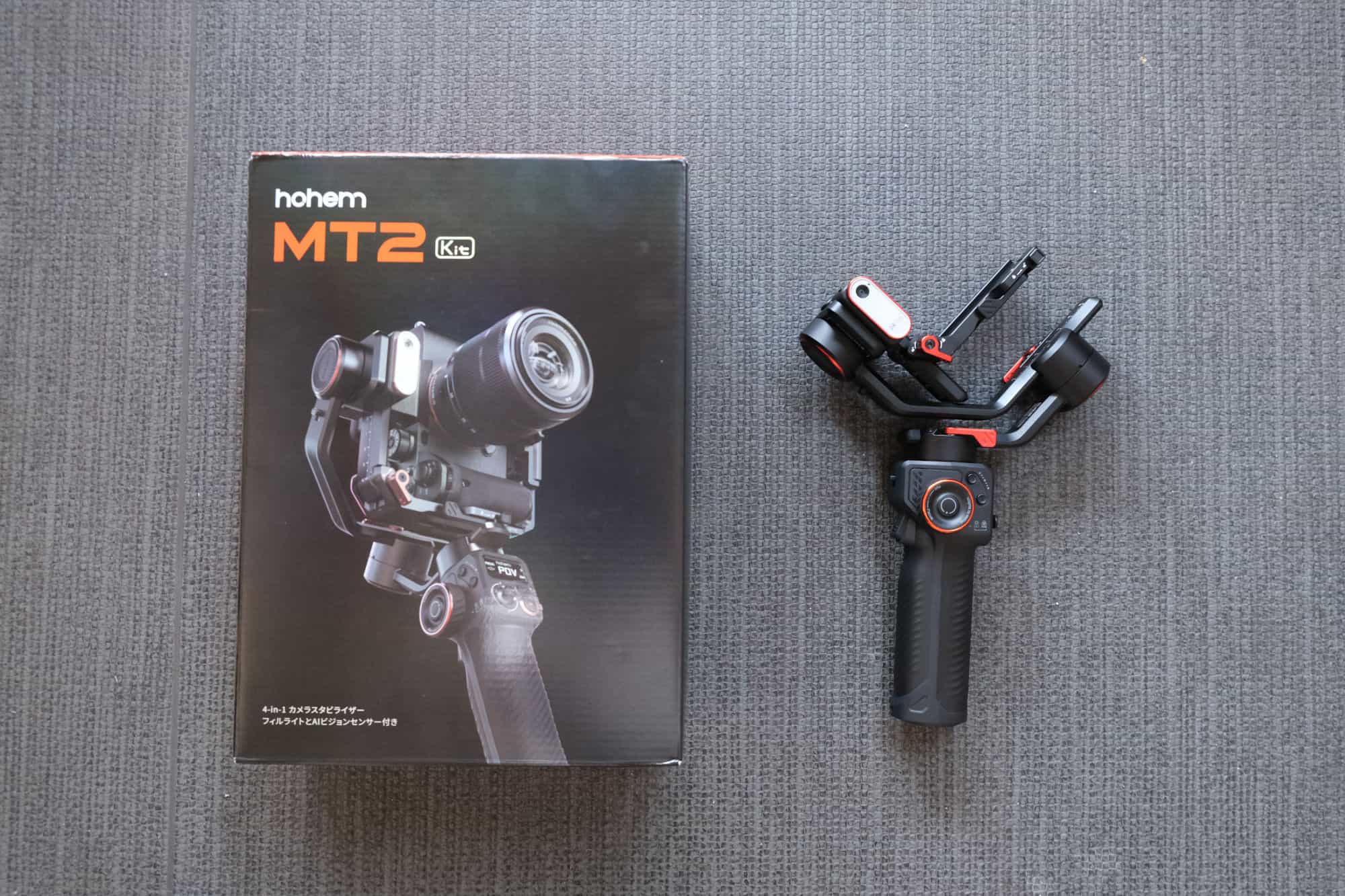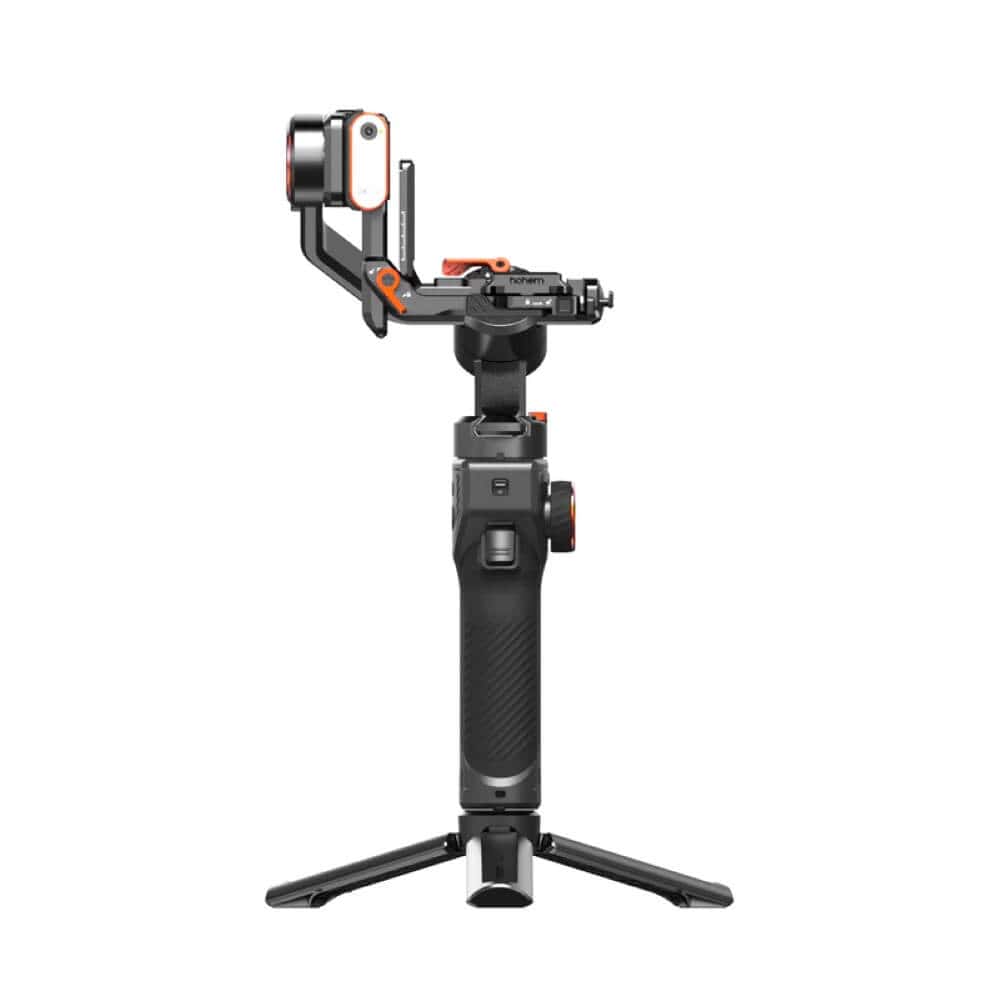The world of content creation is evolving rapidly, with video becoming an increasingly important medium. This has led to a huge demand for tools that can help creators stabilize their footage and achieve cinematic shots without massive budgets.
One product aiming to fill this need is the Hohem iSteady MT2 3-axis gimbal. I’ve had good experiences with Hohem gimbals in the past but they’ve always struggled to truly stand out in such a crowded market.
But by incorporating the Hohem M6’s AI subject tracking to a gimbal that can support mirrorless camera payloads, I was genuinely excited to be able to test out this new gimbal.
Table of Contents
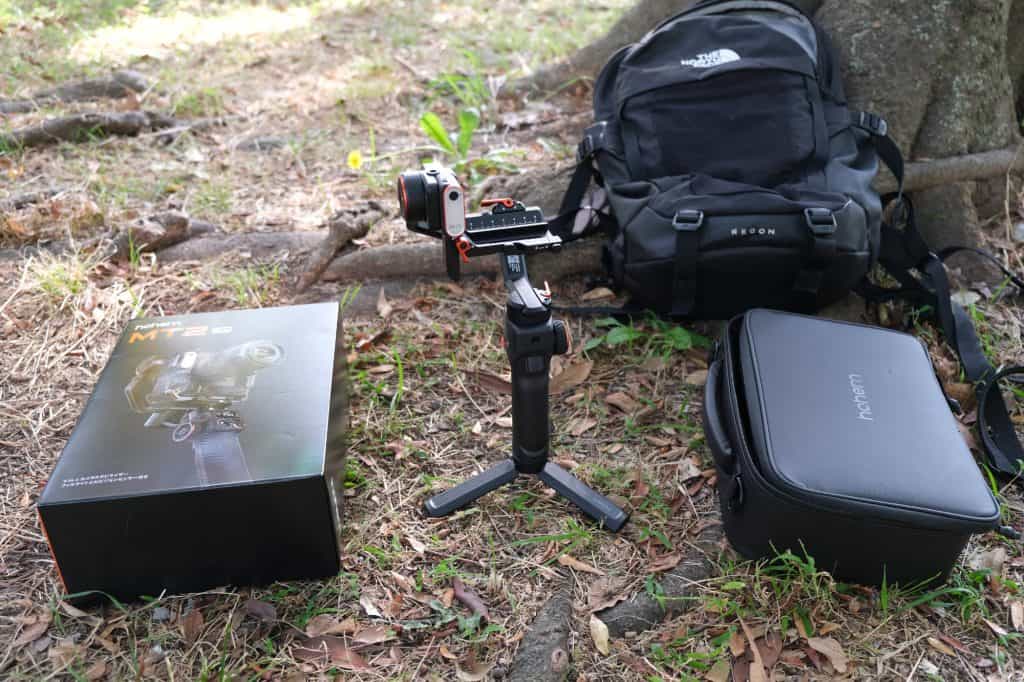
Overview
The iSteady MT2 is an innovative 3-axis gimbal designed for use with mirrorless cameras, smartphones, and action cameras such as the GoPro. This sets it apart from most other gimbals on the market, which are typically designed for use with one type of device. If you’re a hybrid shooter with various recording tools, this wide compatibility could drastically reduce the size of your kit.
The MT2 has a compact, foldable design and weighs just 653g. It’s constructed from sturdy plastics with metallic orange accents that give it some style. It measures 285x115x75 mm unfolded, making it similar in size to the DJI RS3 Mini. It’s therefore very compact as a mirrorless gimbal, but rather big as a smartphone gimbal.
The “Kit” package I tested came with the AI Vision tracking module, a nice carrying case, mini tripod, and an assortment of mounts and cables for different devices. The tracking module has an RGB light which can provide some basic fill lighting. The controls include a joystick, focus wheel, zoom rocker, mode button, and trigger. There’s also an OLED display for monitoring settings.
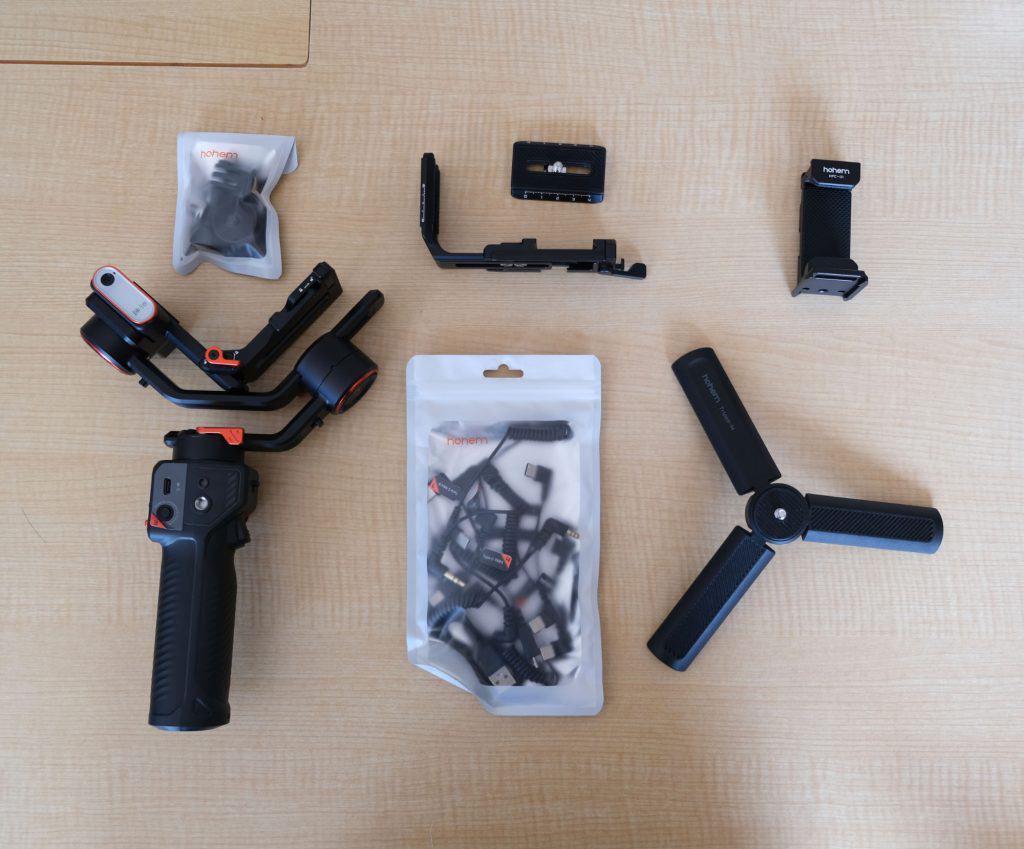
Payload Capacity and Compatibility
With a stated maximum payload of 1.2kg (2.65 lbs), the Hohem MT2 is best paired with smaller mirrorless bodies, although it can technically handle certain full-frame lens combos as well.
As I primarily shoot with MFT and APS-C cameras, the MT2 had no trouble accommodating them. It worked flawlessly with my Sony ZV-E10 and 16-50mm lens, and also my Fujifilm X-T3 with its 18-55mm zoom lens which leans on the heavier side of an APS-C setup.
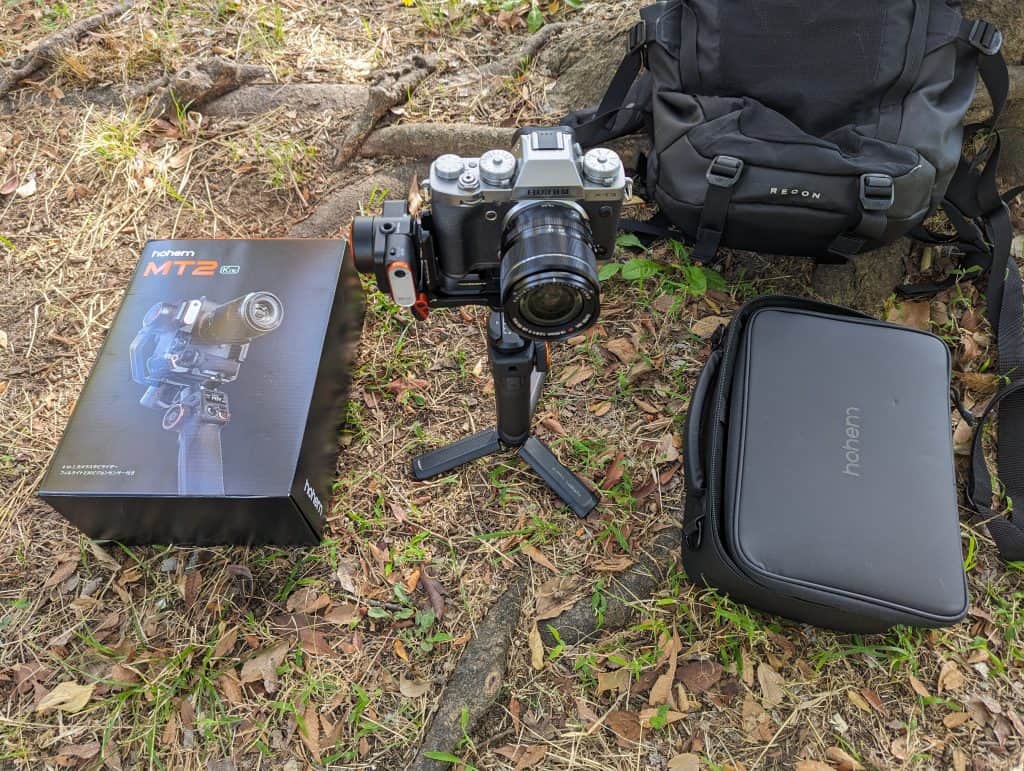
You’ll want to check this compatibility list, but you will also be able to use it for other cameras not listed there as a basic gimbal without cable control, as I did with my XT-3.
Setup and Balancing
Balancing the gimbal is a bit involved but manages to remain tool-less. Each axis has a quick-release lever to allow the gimbal to fold down compactly for transport and storage. There are sliding plates for positioning along each axis. The included Arca Swiss L-bracket makes it possible to switch between landscape and portrait orientations with any device.
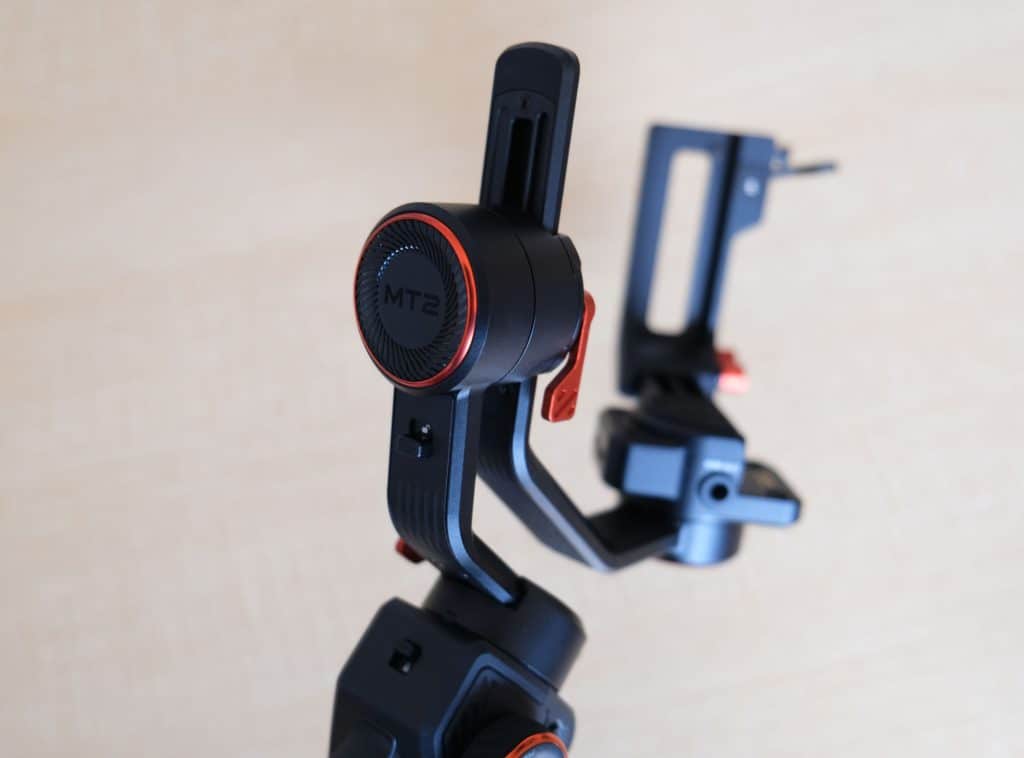
Once you get the hang of it, switching between devices doesn’t take too long, but also not fast enough to make on-the-fly switching on the field smooth. Balancing my mirrorless camera required using both the L-bracket and Arca Swiss plate, which was initially a bit confusing but made sense after following the video tutorial.
I tested the gimbal with various devices including a GoPro, Insta360 Go 3, an iPhone 14 Pro and a Google Pixel 6. Once physically balanced there wasn’t any need for additional configuring or setup in the settings. However, some other reviewers have pointed out that you might face Error 003 and need to adjust the motor torque from the settings when switching between devices of different weights.
Performance
In terms of stabilization, the iSteady MT2 performs remarkably well. All the signature gimbal camera moves like sweeps and rolls are buttery smooth. The motors can handle some fast pans and complicated sequences reliably. Even with a heavy camera setup, I was able to achieve super stable footage. This would give any video sequence an instantly cinematic polished look.
Here are the shooting modes the MT2 provides to handle different situations:
- Pan Follow – The camera pans left/right to follow movement while the tilt and roll stay fixed.
- Pan & Tilt Follow – The camera pans and tilts up/down to follow your movement.
- Lock – Locks the motors to keep the camera fixed in one direction.
- POV – Keeps the camera orientation fixed as you move, as if its your point of view.
- Inception – Rotates the camera during motion for dramatic spinning shots.
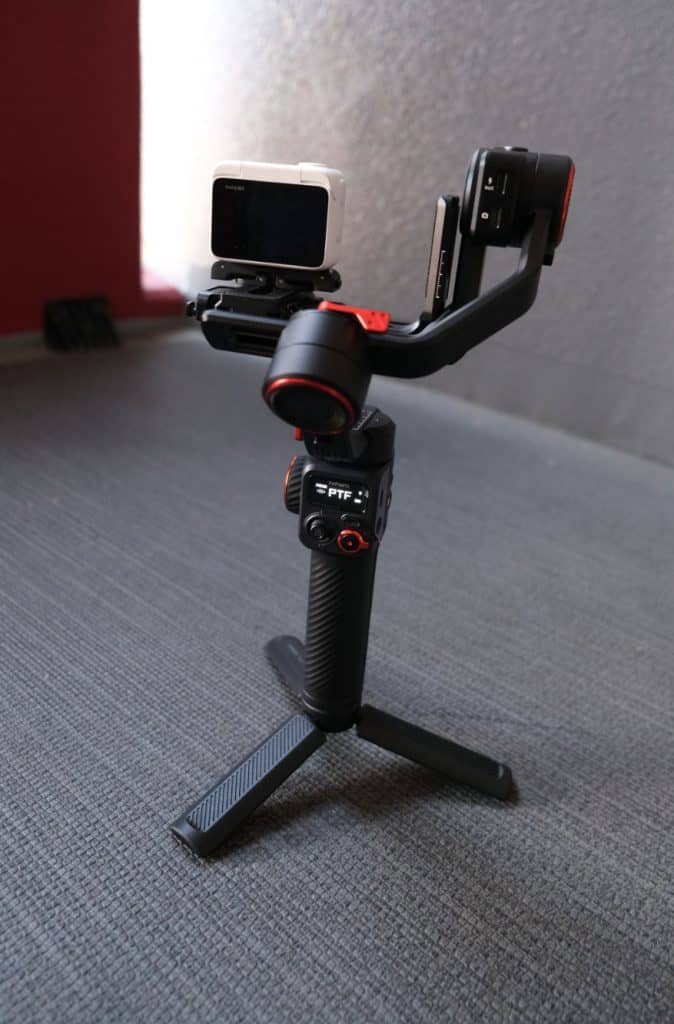
AI Tracking Sensor
One of the MT2’s unique features is its attachable AI Tracking Sensor. This houses both a subject tracking module and an adjustable RGB/CCT light panel.
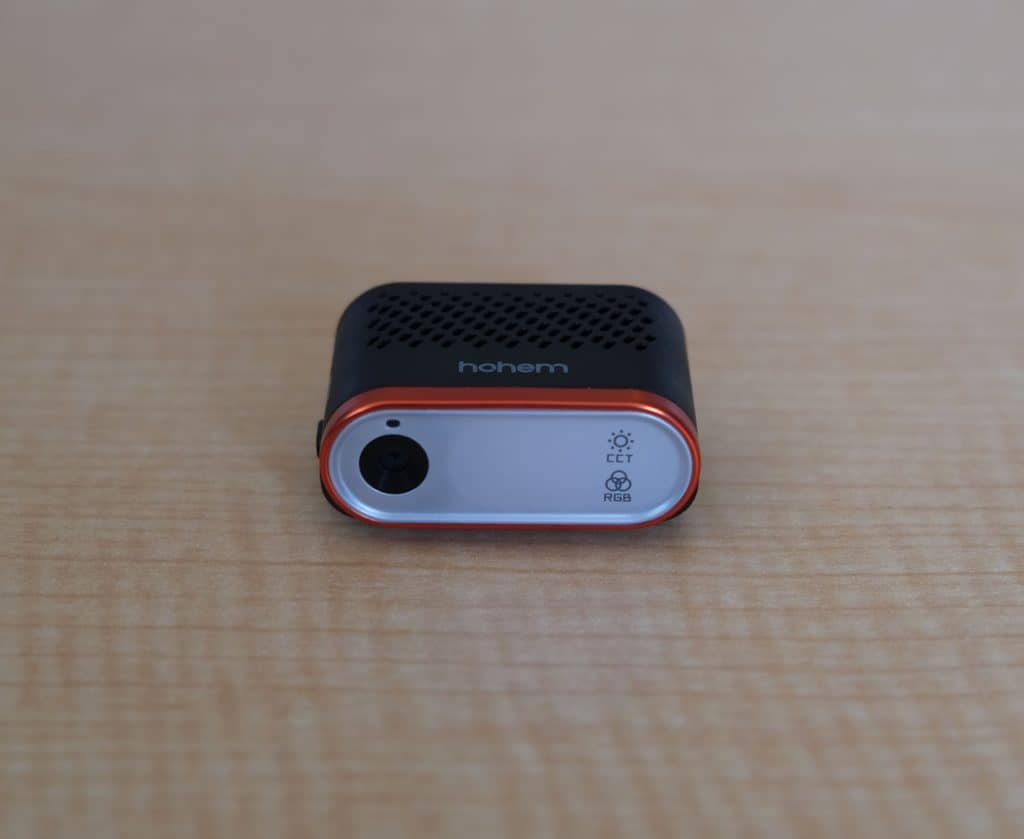
The sensor attaches and detaches easily via built-in magnets. It draws power from the gimbal so no separate batteries or Bluetooth connection is required.
Using it is simple – just perform a particular hand gesture and it will start following you automatically, no phone or app needed. The three gestures are:
- 👌 “OK” sign – Begin tracking
- 🖐 “Stop” sign – Stop tracking
- 👉👈 “Double L” – Reframe shot
Hohem recommends being around 0.5-1.5m away from the sensor when gesturing, but it managed to detect my gestures around 3m away.
In my testing the subject tracking worked surprisingly well in good lighting conditions, smoothly following me around and adjusting the frame to keep me in sight. I was able to stray pretty far from the tracker, comfortably over 10m, with the gimbal staying locked on to me.
If you move behind an object temporarily, the gimbal reacquires you when you reemerge. This is an area which often trips up other subject tracking gimbals. The MT2’s tracking isn’t infallible though – quick motions or obstructing your hands can confuse it momentarily. Performance also drops in low light. The tracking is also limited to people – you can’t track objects. But overall it’s a very impressive package for the price.
Having AI tracking built right into the gimbal makes getting moving shots as a solo videographer incredibly easy. It’s a huge timesaver compared to trying to control the gimbal manually while staying in frame.
AI Tracking Sensor vs tracking on other gimbals
While you can get other gimbal subject tracking technologies like DJI’s ActiveTrack to work with mirrorless cameras, it’s usually a lot of hassle, requiring additional accessories like the RavenEye image transmitter and cable or Bluetooth connections to be established. And that’s assuming your camera is compatible in the first place.
By contrast, the MT2 decouples the subject tracking from the camera entirely and utilizes a standalone tracking unit. In practice, it’s much easier to work with this system than jumping through all the hoops to get things working compared to other gimbals.
It also enables tracking on certain devices like GoPros which can’t run apps.
Now when we’re talking about iPhones and Android phones, the AI tracking sensor doesn’t make much of a difference because smartphone gimbals like the DJI Osmo Mobile 6 and Insta360 Flow can achieve subject tracking over Bluetooth.
The tracking sensor doubles as a fill light
The magnetic AI tracker is also a fill light and can provide a bit of fill when needed. It has adjustable brightness as well as CCT modes ranging from tungsten to daylight. You can even switch it to full RGB color mode to get creative with colored lighting.
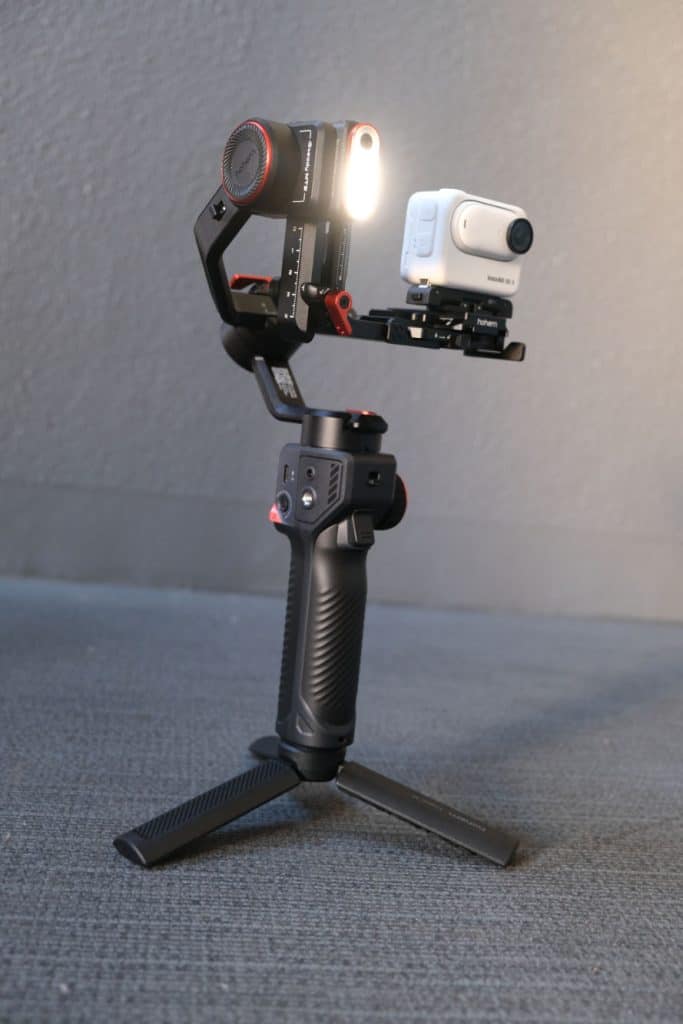
Battery and App
Battery life is rated up to 17 hours but real-world use will be less. Still, it will comfortably get through a full day of shooting. Recharging takes about 3 hours. There is a USB-C port on the gimbal for charging or keeping your camera or phone powered during use.
Connecting to the Hohem Joy app allows remote control of the gimbal from your phone. You can also access modes like time lapse and motion lapse. While it’s possible to change a lot of things from the gimbal’s dedicated controls and OLED screen, you will have to use the app to configure more advanced settings.
Overall, the app worked well although I did occasionally encounter Chinese text pop up. Unlike the DJI Mimo app, there’s thankfully no sideloading required for Android users.
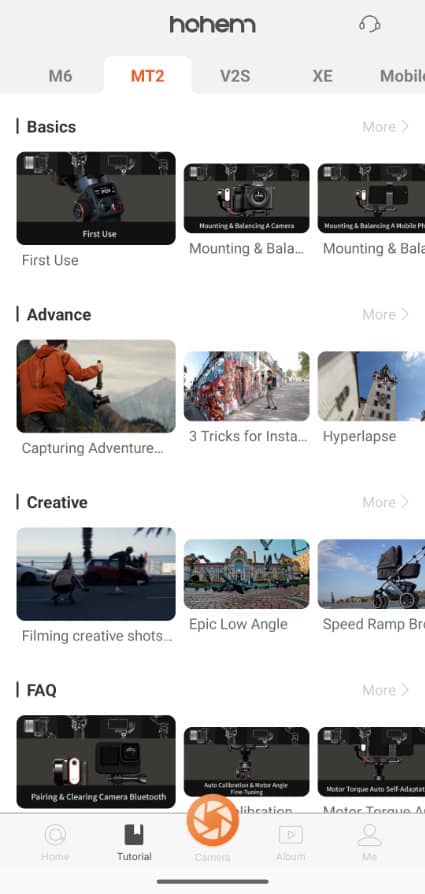
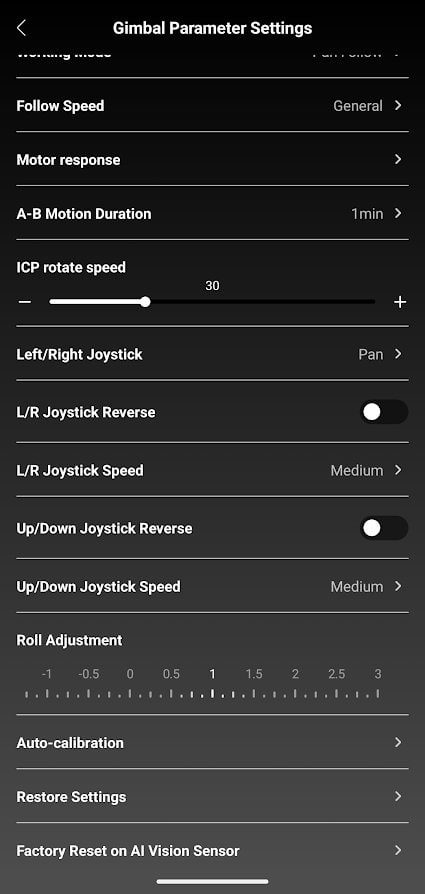
Connectivity and Accessories
The MT2 has a few options for connectivity and accessories:
- Hohem Joy App – Connect your phone over Bluetooth to access more shooting modes, settings, and remote control options.
- Accessory Ports – 1/4″-20 screw accessory threads on the side handle and top axis provide mounting points for mics, lights, or other addons.
- USB-C Port – Enables camera tethering for remote zoom/shutter control, as well as charging.
- Smartphone Mount – A dedicated smartphone holder with Arca Swiss base is included
- Remote Control – The optional Hohem HRT03 remote controller can wirelessly operate the gimbal.
- Tripod – The included mini tripod is helpful for recording and also setting the gimbal down between shots.
- Carrying Case – A handy case provides safe storage during transport.
The MT2 doesn’t have quite as many accessory options as higher-end gimbals, but covers the basics well.
Who is it for?
The iSteady MT2 is an incredibly versatile gimbal and it’s the perfect gimbal for creators who film both with a camera and a smartphone. The tracking skills are a key benefit that could justify the cost alone for vloggers and solo video shooters. The max 1.2kg payload does limit heavier camera setups, but it can easily handle compact mirrorless cameras.
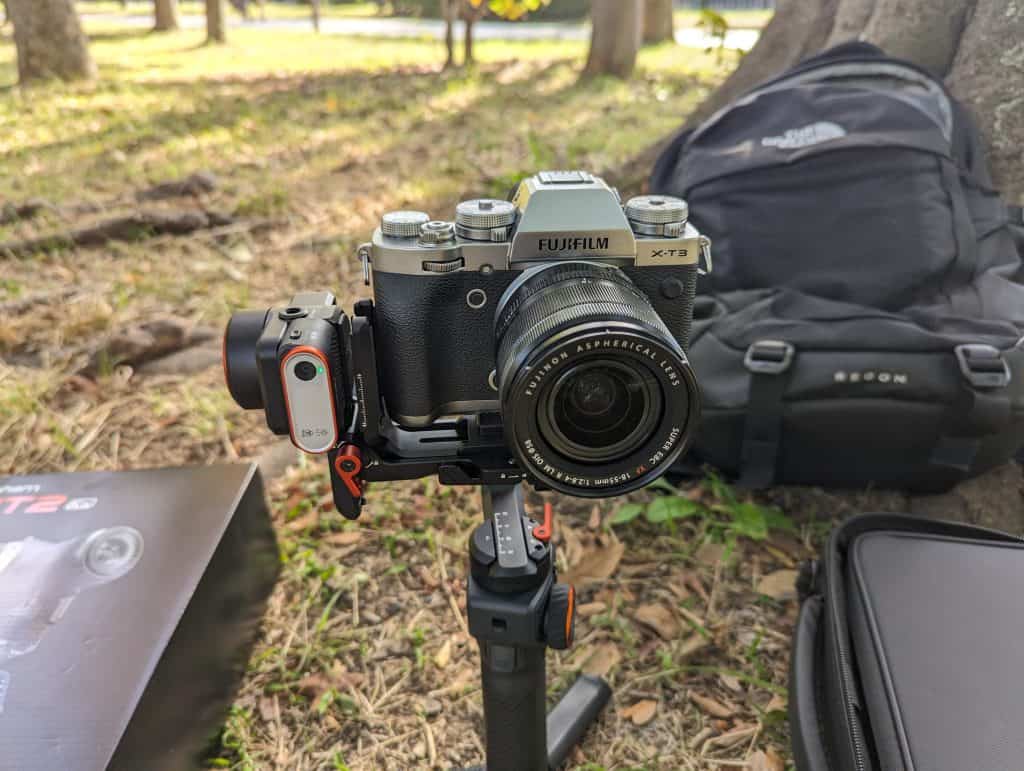
For smartphone creators, a smartphone gimbal is probably sufficient and makes more sense. Not only because they are easier to travel with, but because they are easier to mount and don’t involve a fiddly balancing process.
Even if you only intend to shoot with your smartphone, there is still a case for using the Hohem MT2, however. Here are several advantages it has over phone gimbals:
- The MT2 benefits from stronger motor torque to keep up with faster action
- It has a greater range of motion than the likes of the DJI Osmo Mobile 6 or Insta360 Flow, which sacrifice movement range in certain axes in order to fold up so compactly.
- The bigger grip affords much better ergonomics while recording
And of course, beginners wanting a gimbal that can grow with multiple camera types should definitely consider the iSteady MT2.
The competition
The iSteady MT2’s closest competition comes in the form of the DJI RS3 Mini and Zhiyun Crane M3S. Both 3-axis gimbals are priced close to the MT2, and are lightweight gimbals suited towards lighter camera combos.
iSteady MT2 vs DJI RS3 Mini
- Payload: The MT2 supports up to 1.2 kg while the RS3 Mini supports up to 2 kg.
- Tracking: The MT2 has an independent tracking sensor that can track subjects. The RS3 Mini only offers ActiveTrack on a small number of compatible cameras.
- Smartphone Support: The MT2 comes with a dedicated phone holder and can use the Hohem Joy app for recording. The RS3 Mini requires a separate phone holder and can only use the native phone camera app.
- Battery Life: The MT2 has a longer max battery life at 17 hours vs 10 hours on the RS3 Mini.
- Ports: The MT2 has quarter-inch threads while the RS3 Mini uses NATO ports.
- Fill Light: The MT2 has a built-in adjustable fill light. The RS3 Mini does not have a light.
- Customizable Dial: The RS3 Mini has a customizable dial to control camera settings. The MT2 does not have this dial.
iSteady MT2 vs Zhiyun Crane M3S
- Size: The Crane M3S is slightly more compact than the iSteady MT2
- Battery life: The MT2 has a longer battery life of 17 hours, compared to around 7.5 hours for the Crane M3S.
- Payload: Zhiyun does not specify a payload capacity, but claims it can handle a Sony A7+24-70mm f4 which is similar to the MT2’s max payload. But the MT2 might fare better with big setups because the gimbal arms have more clearance.
- Accessories: The MT2 has an extra mounting point on the roll motor for adding weights, making balancing easier.
- Screens: The Crane M3S has a brighter, responsive touchscreen while the MT2 relies more on the app for adjustments.
- Tracking: The MT2 has an AI tracking mode that’s very effective for tracking people. The Crane M3S lacks a comparable tracking feature.
Overall the iSteady MT2 seems to one-up the Zhiyun Crane M3S, which doesn’t offer significant advantages of its own.
The DJI RS3 Mini, on the other hand, is potentially worth considering because it can work with heavier kit. However, it does not support using the ActiveTrack function with the RavenEye Image Transmission System, and can only use tracking via camera connection with a very limited number of cameras.
Verdict
Ultimately, the Hohem iSteady MT2 brings the stabilization and subject tracking capabilities previously only found in high-end gimbals with complicated setups to a much more accessible price point.
If face tracking with your camera is important to you, there is no alternative at this price point. The fact it operates independently from the camera also offers some unique advantages.
Without the tracking, the MT2 is still a compelling gimbal in its own right, thanks to its compact size and compatibility with smartphones and action cameras. While there are definite advantages to having dedicated gimbals for your recording devices, a dual-purpose gimbal like the MT2 will save you money and space.
For creators looking to elevate their videos, the MT2 earns a strong recommendation as a capable do-it-all gimbal available today.
9/10
Hohem iSteady MT2
- Compatible with different types of camera
- Hassle-free AI tracking
- Solid build quality and good ergonomics
- Long battery life
- No axis auto locking
- Balancing procedure more complicated than phone gimbals

